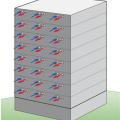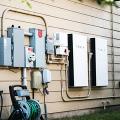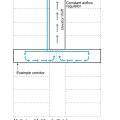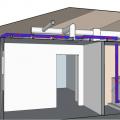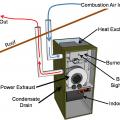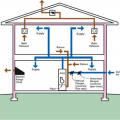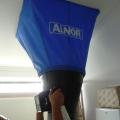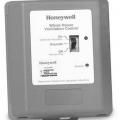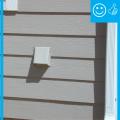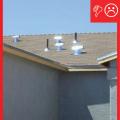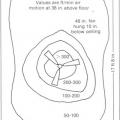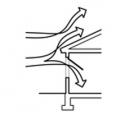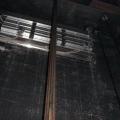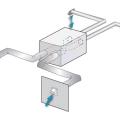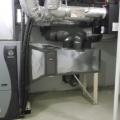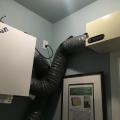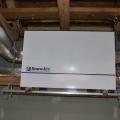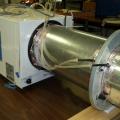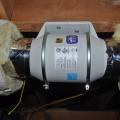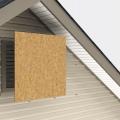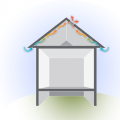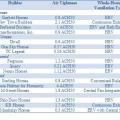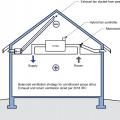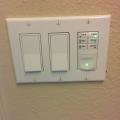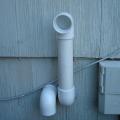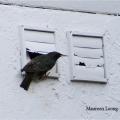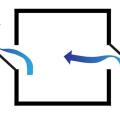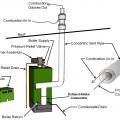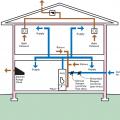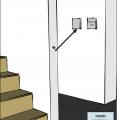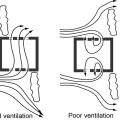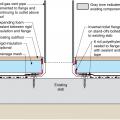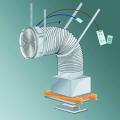Showing results 1 - 50 of 248
Individual ventilation systems for each dwelling unit in a multifamily building will require large numbers of penetrations in exterior facades
A battery storage system can provide reliable back-up power during a grid power outage
A central fan-integrated supply system uses a fresh air intake ducted to the home's central furnace or air handler unit to supply fresh air throughout the home
A central rooftop fan supplies outdoor air to all floors of a multistory multifamily building, pressurizing the corridors and providing make-up air for the elevator shaft, which is depressurized by an exhaust fan.
A central rooftop fan supplies preconditioned outdoor air to every floor of a multistory multifamily building, pressurizing the corridors and providing make-up air for the elevator shaft, which is depressurized by an exhaust fan.
A Corsi-Rosenthal Box is a highly effective DIY air cleaner made of easy to obtain materials such as HVAC filters, a box fan, cardboard, and tape
A direct-vent sealed-combustion fireplace takes its combustion air directly from outside through a dedicated air inlet and vents combustion products directly outside
A direct-vent sealed-combustion furnace has dedicated pipes for combustion air and exhaust
A fresh air inlet is ducted to the return side of the home’s central air handler; a motorized damper and electronic controls help balance the flow of fresh incoming air with controlled exhaust to meet ventilation requirements
A mini-split air-conditioning system can be a highly effective low-energy approach to provide cooling to one designated zone in the house
A passive air inlet is one approach to providing makeup air when operating an exhaust-only ventilation system
A passive flow hood is used to measure the flow rate of air that passes through a ceiling-mounted exhaust fan
A powered flow hood is used to measure outside air flowing into the inlet terminal of a whole-house ventilation system
A shallow, open floor plan allows free flow of cross ventilation through the house
A triple-filtered energy recovery ventilator is installed with individual supply ducts to provide fresh air to each room.
A ventilation controller with a manual override is located on a central air handler fan that is located in an accessible location
Air speeds generated by a typical ceiling fan are in the ideal range for providing occupant cooling without causing disruption
Airflow can be directed across thermal mass in the ceiling, floor, or elsewhere inside the home through various window and louver configurations
An elevator shaft vent with a motorized damper in a multistory multifamily building provides smoke and hot gas control in an elevator shaft during fire events; during normal operation the damper remains closed to reduce energy loss.
An energy recovery ventilator (ERV) transfers both heat and moisture between incoming and outgoing streams of air
An energy recovery ventilator draws in fresh outside air that is filtered and circulated by the central air handler, while stale air from central returns is routed through the ERV to exchange heat before being exhausted outside.
An energy recovery ventilator provides filtered fresh air to every room in the house.
An energy recovery ventilator with a MERV 13 filter supplies clean, fresh air to the entire home.
An ERV provides fresh air to the home while removing stale air and recovering heat.
An in-line airflow station installed in rigid duct provides a location to measure ventilation airflow
An in-line exhaust fan supplements the ability to exhaust moisture-laden air and lint from a dryer
Attach a strong permanent cover to gable end vents before a severe storm strikes to prevent moisture intrusion.
Attic ventilation fans exhaust hot air from the attic while replacing it with cooler air from the outside through intake vents
Baffles allow ventilation under roof decking while keeping wind from blowing insulation back from the edges of an attic.
Balanced ventilation dominates ventilation specifications by Zero Energy Ready Home builders
Bathroom exhaust fans are timer-operated to encourage removal of moisture from the home.
Because flue temperatures are cool, intake and exhaust ducts on a Category 4 direct-vent sealed-combustion condensing furnace can be made of PVC
Casement windows or wing walls can create zones of higher pressure (right) and lower pressure (left) to encourage cross ventilation when wind is flowing parallel to window openings
Central-fan-integrated supply ventilation with exhaust fans for intermittently balanced whole-house ventilation
Comfort ventilation focuses on airflow over occupants; in this example of wind-driven cross ventilation, the air is directed through the main occupied areas of the bedroom
Continuously-operating ventilation & exhaust fans include readily accessible override controls
Dense hedges can encourage cross ventilation (left image) or not (right image) depending on how they are placed relative to windows
Detail of radon vent stack connection to existing basement slab – retrofit basement construction
Ducted whole-house fans should be installed with the duct curved and the fan suspended from rafters to reduce noise and vibration transmission to the living area.
Each unit in a multifamily building should have its own supply and exhaust ventilation
